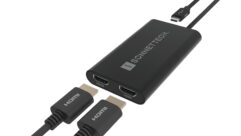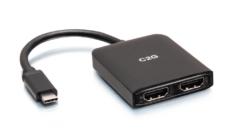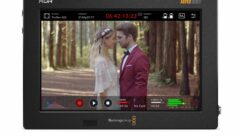
Video Review: Gefen USB to DVI Graphics Adapter
Jul 1, 2008 12:00 PM,
By Jeff Sauer
A small device easily outputs video from a USB to an external DVI port.

Video comes out of a computer through the 15-pin RGB, or if you’ve got a more modern computer, you might use a DVI port. That’s pretty simple stuff for an AV professional, isn’t it? But what if the video came out through the USB port?
That’s just what Gefen’s USB to DVI Graphics Adapter ($129) does: one end plugs into the USB port on a notebook or desktop computer, and the other end plugs into the DVI port on an external monitor, projector, or other display. And, voila, the computer video output shows up just as if it were a standard VGA cable.
Physically, the Gefen USB to DVI Graphics Adapter is just a small device — about the size of a cellular phone — with a DVI port on one end and a mini- USB port on the other. Gefen includes a 1-meter USB cable that connects to the adapter on one end, with a standard USB port that will plug directly into a computer on the other end. There’s also a DVI-to-female RGB converter, replicating the analog monitor out of a standard laptop should you need a standard analog connection. (Gefen sells a USB-to-VGA adapter for $99 that omits the DVI port in favor of a 15-pin analog output.)
The adapter can output both signals thanks to — among other things — a graphics chip from the OEM DisplayLink inside in the unit. DisplayLink’s driver, which must be installed on a computer prior to use, effectively intercepts the Windows display information before it gets to the onboard graphics hardware and sends the appropriate portion of it through the USB port to the graphics chip in the adapter. You can still use the onboard graphics to drive your primary and secondary monitors just as you ordinarily would.
In fact, the user experience with the adapter is exactly the same as with any other external monitor, except that there are no laptop key combinations necessary to activate the extra displays. The USB to DVI Graphics Adapter simply appears in the Windows’ desktop Properties Setting dialogue box. From there, you can “extend your Windows desktop onto this monitor.” Or, if you deselect the Extend option, the adapter automatically goes into mirror mode, displaying the same image on both the primary local monitor and the monitor to which the adapter is connected.
It’s that simplicity that is one of the main advantages of the USB to DVI Graphics Adapter. And, because it’s a USB device, it’s hot-pluggable. There’s no rebooting as long as the driver has been pre-installed, and that’s a potential boon for conference speakers and assisting AV pros. Admittedly, swapping a USB cable between speakers at a conference is really not that much different than handing around an RGB cable to plug into the back of each speaker’s laptop. Yet, an AV pro who has worked conferences knows that Windows laptops often aren’t that simple. By allowing the DisplayLink driver to take control of the graphics output, you can assume a standard experience for every laptop computer that comes to the podium. (There is a Mac OS X driver that is current in a public Beta release on the DisplayLink website. There are some known issues that DisplayLink is addressing prior to a final release. Gefen expects to include the Mac OS X driver once it is finalized.)
In addition to conferences, the Gefen USB to DVI Graphics Adapter is likely to be the simplest and most affordable way to add a second, third, or fourth monitor to a desktop computer. In fact, you can add as many adapters and monitors to your desktop as you have USB hub ports. The caveat is that bandwidth will start to become an issue.
BANDWIDTH IS KING
USB 2.0 has a theoretical bandwidth of 480Mbps, and that’s more than enough for displaying most types of content — even at the adapter’s maximum resolution of 1600×1200. For example, I was able to play high-definition video over the USB with very limited degradation in smoothness on an Windows XP system. However, it’s asking a lot of the available bandwidth, and it gets a lot harder for the adapter to keep up if the image is zoomed to full screen or if the video playback becomes a background task to another active window. Fast-motion videogaming can also push past the available bandwidth, and while presumably that will not be an issue for most AV professionals, it does illustrate the performance threshold.
What’s more, not all computers and their respective USB 2.0 interaction are created equal. I also tested the adapter on a 3-year-old 1.5GHz XP professional notebook computer, and I could not achieve the same performance — a result of the less powerful computer CPU. The greater system overhead of new Vista computers also takes a small bite out of performance, and it can result in more dropped frames when playing either motion video or fast-motion games; however, a forthcoming version of the DisplayLink driver seems to increase the adapter’s efficiency.
The USB to DVI Graphics Adapter will even work with an older USB 1.0 computer or hub, but don’t expect the same performance from just 12MB worth of bandwidth. In my tests, the adapter would not display a 1600×1200 resolution image at all, and a 1280×1024 was not practicable. However, XGA did work, but with a noticeable latency and no chance of keeping up with something such as motion video. Still, for many business presentations, the simplicity still may be an acceptable trade-off.
One final performance note: Image quality was noticeably softer and brighter when using Gefen’s DVI to VGA Adapter.
CONCLUSION
What is to be gained from USB as opposed to traditional RGB or DVI? Is a 1-meter USB cable really long enough to be very liberating? The answer depends on how you’re likely to use the adapter. If you compare Gefen’s USB to DVI Graphics Adapter to buying and installing a second graphics card in a desktop computer for more onscreen work area, it’s really an affordable and very simple solution — and the 1-meter cable certainly adds more flexibility than plugging your DVI or RGB cable into the back of the computer chassis.
As a solution for conferences and panel discussions, there’s no question that relying on USB rather than the predilections of multiple presenters’ notebook computers will make setup quicker and easier. The big caveat being that each must have the driver pre-installed. However, you’re still passing around and plugging in a cable, but DisplayLink is working on that too. It is now demonstrating a future chip with integrated wireless USB. Unfortunately, that product is likely several months away, but it does hint at the increasing ease of the USB display solution.
PRODUCT SUMMARY
- Company: Gefen www.gefen.com
- Product: USB to DVI Graphics Adapter
- Pros: Simple plug-and-play USB device makes adding an external monitor very easy.
- Cons: 1-meter cable isn’t very liberating.
- Applications: Conference and business applications where simplicity is key.
- Price: $129
SPECIFICATIONS
- Protocol: USB 2.0
- Output resolutions: Up to 1600×1200 (UXGA)
- Operating system: Windows XP/2000/Vista
- System requirements: 1.2GHz or higher, 256MB RAM
- Cable: 1-meter USB
- Warranty: One year parts and labor










